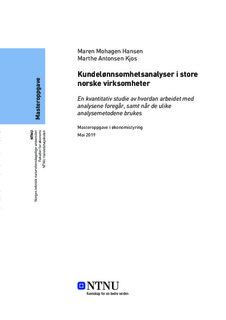| dc.description.abstract | Formålet med denne studien er å kartlegge hvordan store norske virksomheter arbeider med kundelønnsomhetsanalyser, samt undersøke hvilke faktorer som påvirker bruk av de ulike analysemetodene for kundelønnsomhet. Dataene er samlet inn ved hjelp av et elektronisk spørreskjema der det ble registrert 116 svar.
Blant respondentene i utvalget er det 86,1% som benytter kundelønnsomhetsanalyser i større eller mindre grad. Studien etterspør bruk av de ulike analysemetodene for kundelønnsomhet på en indirekte måte, der tidligere studier har spurt på en mer direkte måte. Funnene knyttet til bruk og nytte av kundelønnsomhetsanalyser er imidlertid i tråd med det tidligere studier har funnet, og det ser derfor ut til at det er like navn på analysemetodene i praksis og akademia. Resultatene viser videre en gjennomgående høyere nytte enn bruk av de ulike analysemetodene, noe som tyder på at virksomhetene har tro på kundelønnsomhetsanalyser som styringsverktøy. Dette støttes av at respondentene mener at kostnaden ved å utføre analysene er verdt informasjonen de gir, og at hyppigere oppdateringer av analysene forbindes med økt kvalitet i analysene.
Videre avdekkes det at virksomhetene i studiens utvalg har høy grad av teknisk og organisatorisk ressurstilpasning i kunderelasjonene sine, samt at virksomhetene har gjennomgående høy grad av markedsorientering. Disse faktorene benyttes videre i fire regresjonsmodeller, hvor hensikten er å teste et rammeverk utviklet av Lind og Strömsten (2006). Rammeverket tilsier at teknisk og organisatorisk tilpasning av ressurser i bedriftens kunderelasjoner kan ha betydning for valg av analysemetode for kundelønnsomhet. Regresjonsanalysene viser lave forklaringsgrader. Det kan dermed virke som det er andre faktorer som har betydning for bruk av de ulike analysemetodene for kundelønnsomhet, og som er utelatt i denne studien. Videre er det få signifikante variabler, og vi finner ikke støtte for studiens hypoteser relatert til når virksomheter bruker de ulike analysemetodene for kundelønnsomhet. Disse funnene utfordrer av den grunn eksisterende forskning.
Til tross for få signifikante variabler ser vi at variablene viser forskjellig signifikansnivå i de fire ulike regresjonsmodellene. Dette impliserer at kundelønnsomhetsanalyser derfor bør behandles som fire ulike analysemetoder fremfor én helhetlig metode. | |
| dc.description.abstract | The purpose of this study is to describe how large Norwegian companies work with customer profitability analysis, and to examine which factors are affecting the use of different practices for customer profitability analysis. Using electronic surveys, 116 answers were collected. Amongst the respondents, 86,1% use customer profitability analysis to a certain degree.
Whereas previous studies have expressed the questions regarding the use of customer profitability analysis in a direct way, this study takes a more indirect approach. However, this does not seem to affect the results in any way worth mentioning. The results of the study agree with what former studies have shown. Therefore, it seems like the different customer profitability practices, have the same appellation in practice and in academia. The findings show that the perceived merit score for each of the four customer profitability practices is higher than their usage rate scores, which indicates an unrealized potential in the use of customer profitability analysis. Moreover, the study show that the information obtained from the analyses, are worth the costs, and that frequent updates of the analyses responds to increased quality.
Next, which factors effects the use of different practices for customer profitability analysis is examined. Lind og Strömsten (2006) developed a framework connecting technical and organizational interfaces with different practices of customer profitability analysis. The framework is re-examined in this study. We also test whether the businesses’ degree of market-orientation have any influence on the choice of method, and other contingency variables that have shown importance in the use of other management accounting systems. The regression analysis shows low coefficients of determination, which indicate that there are other factors than the ones included in this study, having effect on the choice of practice of customer profitability analysis. Few significant variables is found, which means that we are not able to confirm our hypothesis related to the framework developed by Lind og Strömsten (2006).
Even though the findings show few significant variables, the analysis show different significant- levels in the four different regression analysis. This indicate that customer profitability analysis should be treated as four different methods of analysis, rather than one general practice. | |
